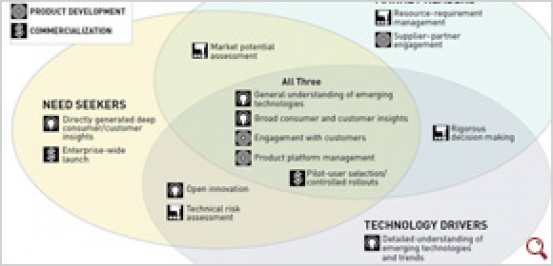
18-08-2014
Booz & Company: Navigating the Digital Future
inventoo.com is positioned to approach innovation like studies and report say it must be done. Big companies CEOs are open to direct market inputs to acelerate innovation and new products offer to the market. Some call it a concept of open innovation (to outside company inputs), but at the end of the day it is for all and everywhere, so it's cloud innovation, as inventoo.com.
---
THE GLOBAL INNOVATION 1000
1. Navigating the Digital Future
Year after year, our Global Innovation 1000 study has demonstrated that it is not how much companies spend on research and development that determines success — what really matters is how those R&D funds are invested in capabilities, talent, process, and tools. In addition to our recurring analysis of R&D spending trends, our ninth annual study of the world’s 1,000 largest publicly listed corporate R&D spenders focuses on the digital enablers of the innovation process: how the most successful companies are — and aren’t — using digital tools and processes to improve speed, decrease cost, enhance quality, reduce complexity, and sharpen insight into customer and market needs to improve their innovation efforts.
(for more details go to http://www.strategyand.pwc.com/global/home/what-we-think/reports-white-papers/article-display/2013-global-innovation-1000-study)
2. Innovation Strategy Models
The success of each of the strategies depends on how closely companies, in pursuing innovation, align their innovation strategy with their business strategy and how much effort they directly devote to understanding the needs of end-users.
Need Seekers - These companies actively engage current and potential customers to shape new products, services, and processes; they strive to be first to market with those products.
Market Readers - These companies watch their markets carefully, but they maintain a more cautious approach, focusing largely on creating value through incremental change.
Technology Drivers - These companies follow the direction suggested by their technological capabilities, leveraging their investment in research and development to drive breakthrough innovation and incremental change, often seeking to address the unarticulated needs of their customers.
Over the years, we have studied these three strategy models in some detail and identified the capabilities, the goals and cultural attributes, and the front-end innovation process characteristics that are required to be successful with each of these models.
Critical innovation capabilities - In 2010, we set out to determine the capabilities that are the most critical for the success of each of the three innovation strategy models and showed that companies that can craft a tightly focused set of innovation capabilities in line with their particular innovation strategy — and then align them with other enterprise-wide capabilities and their overall business strategy — get a better return on the resources they invest in innovation.
No matter which of the three innovation strategies they pursued, all the successful companies depended on a common set of critical innovation capabilities. These include the ability to gain insights into customer needs and to understand the potential relevance of emerging technologies at the ideation stage, to engage actively with customers to prove the validity of concepts during product development, and to work with pilot users to roll out products carefully during commercialization. Click on the embedded graphic for more details.
In addition to these common capabilities, companies among the top 25 percent in performance within each strategic group depended on a set of distinct capabilities they feel are critical to achieve success, some of which overlap with those of other strategies.
For Need seekers, for example, directly generated deep consumer insights are key to success, whereas for Market Readers supplier-partner engagement is top of the list of important capabilities. Successful Technology Drivers, finally, typically excel at understanding in detail emerging technologies and trends.
The most successful companies, we found, are those that focus on a particular, narrow set of common and distinct capabilities that enable them to better execute their chosen strategy.
Strategic goals and cultural attributes - In 2011, we set out to determine which strategic goals and cultural attributes lead to the greatest success within a given innovation strategy, and how those goals and attributes contribute to the capabilities needed to achieve that success.
As when studying the critical capabilities required for success, we found that all successful companies following any of the three strategy models share some of the most important innovation goals and cultural attributes, like the goal of superior product performance and quality supported by a culture of passion for and pride in the products and services offered.
Each model, however, also has distinct goals and attributes; these can be seen by clicking on the embedded graphic.
The front-end innovation process - In 2012, we set out to identify the tools and mechanisms used by companies in each innovation strategy at the “front end” of the innovation process – during idea generation and idea conversion.
As when studying the critical capabilities and cultural elements required for success, we found that all successful companies following any of the three strategy models share some of the most important front-end innovation tools and mechanisms, such as direct customer observation and cross-unit staffing.
Each model, however, also has distinct front-end innovation tools and mechanisms; these can be seen by clicking on the embedded graphic.
Digital enablers of the innovation process - In 2013, we identified the digital tools and processes that companies pursuing each innovation strategy use to enhance their innovation value chains.
As with other aspects of innovation we’ve studied this way, we found that all successful companies following any of the three strategy models are alike — in this case, in their use of some of the most important digital enablers, such as big data tools, crowdsourcing, and collaborative environments.
Each model, however, also has a few distinct tools and processes in its digital tool kit; these can be seen by clicking on the embedded graphic.
Innovation capabilities for the next 10 years - In 2014, we identified the specific innovation capabilities and processes that companies pursuing each innovation strategy believe will be critical to their success over the next decade.
As with other aspects of innovation we’ve studied this way, we found that companies following any of the three strategy models agreed on the set of capabilities that will be most useful: developing and retaining people with the right technological knowledge as well as aligning their company’s innovation portfolio with customer wants and needs.
The models remain distinct, however, in their priorities for other capabilities and processes; these can be seen by clicking on the embedded graphic.
3. How do the Top Innovatores Keep Winning?
Every year our annual Global Innovation 1000 study investigates the relationship between how much companies spend on R&D and their overall financial performance. And every year, we reinforce the conclusion that there is no correlation between the two. What matters instead are the capabilities that successful companies put together to enable their innovation efforts.
We have found that nearly every company follows one of three strategies, need seeker, market reader, or technology driver. And for each of these strategies, there is a distinct set of capabilities that top performers identify as most critical.
And for those companies that focus on the “right” capabilities, execute them well and align their innovation strategy with overall corporate strategy, we have observed what we call a “coherence premium”. We have found that companies ranked in the top third in terms of coherence had 22 percent higher profit margins, on average, and achieved 18 percent greater market capitalization growth.







